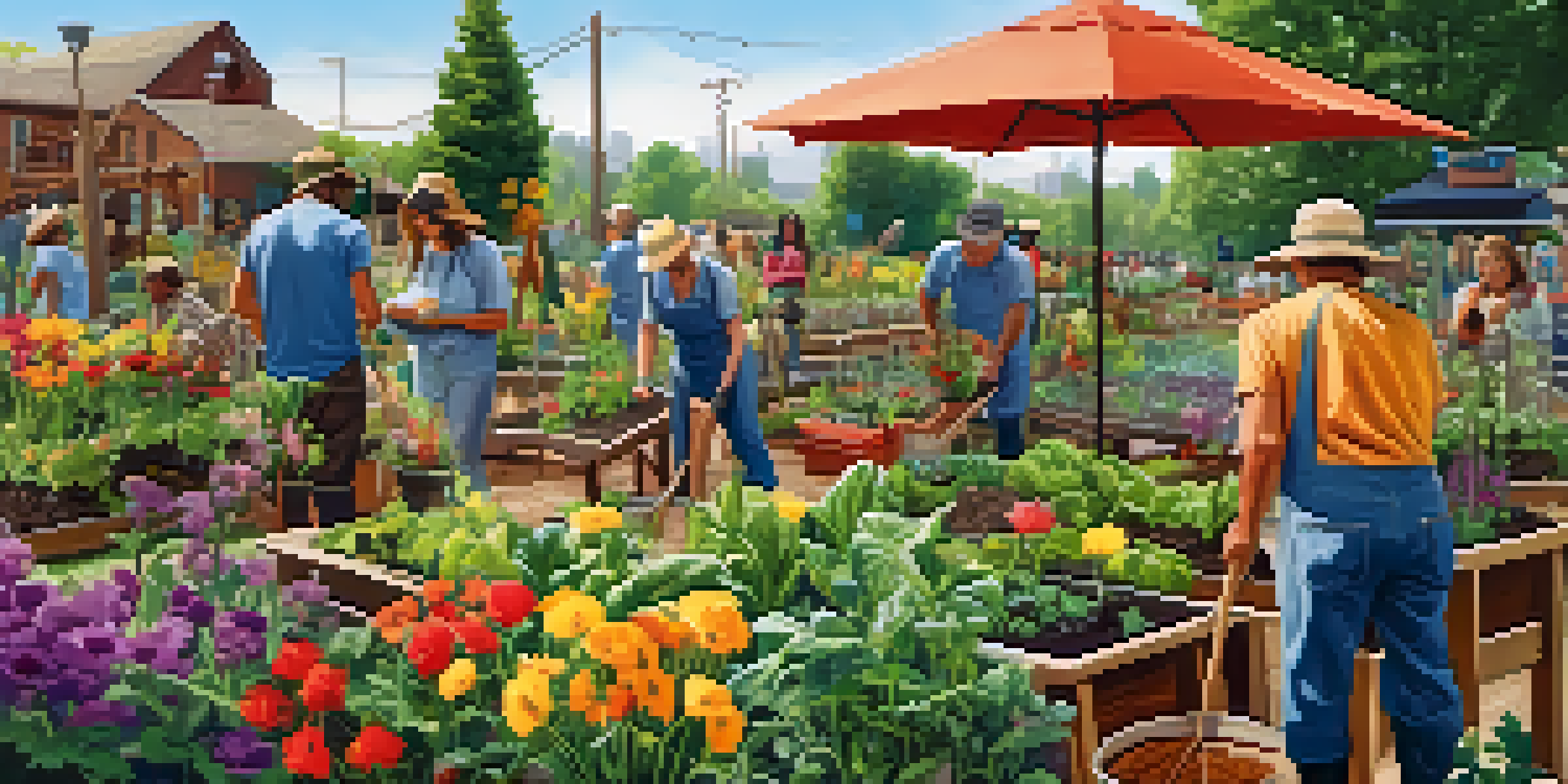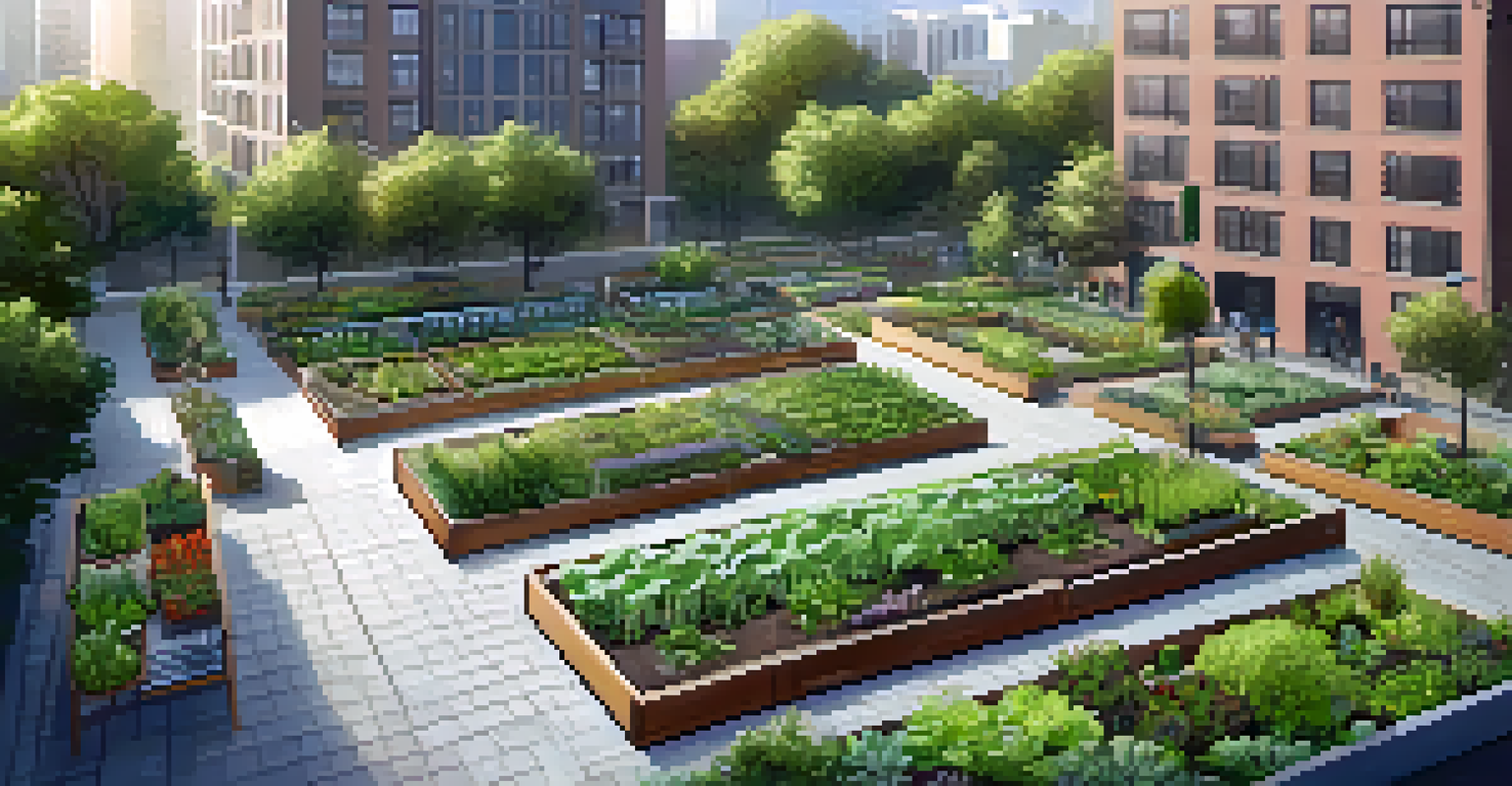Community Gardens: A Grassroots Movement for Urban Change

What Are Community Gardens and Their Purpose?
Community gardens are collaborative spaces where individuals come together to cultivate plants, grow food, and create a sense of community. Often found in urban areas, these gardens transform vacant lots into vibrant green spaces, enriching the environment and the lives of residents. They serve multiple purposes, from providing fresh produce to promoting social interaction and environmental awareness.
Gardening adds years to your life and life to your years.
These gardens can vary in size and structure, ranging from small backyard plots to expansive community farms. The beauty of community gardens lies in their inclusivity; anyone can participate, regardless of gardening experience. This diversity of participants fosters a sense of ownership and pride in the garden, making it a true reflection of the community's values.
Moreover, community gardens can address food insecurity by providing access to fresh fruits and vegetables. In many urban areas, grocery stores may be scarce or too expensive, making it difficult for residents to eat healthily. By growing their own food, community members can improve their diets while also saving money.
The Environmental Benefits of Community Gardens
Community gardens play a significant role in improving urban environments. They help reduce air pollution, combat heat islands, and promote biodiversity by providing habitats for various plant and animal species. These green spaces also absorb rainwater, reducing runoff and improving water quality in nearby streams and rivers.

Additionally, gardens can enhance urban aesthetics, making neighborhoods more appealing and pleasant to live in. Imagine walking through a city filled with colorful flowers, lush vegetables, and the sounds of nature—it's a refreshing contrast to concrete and asphalt. This greenery not only beautifies the area but can also increase property values.
Community Gardens Foster Connection
These gardens bring together individuals from diverse backgrounds, promoting social interaction and a sense of belonging.
Participating in community gardening can also educate individuals about sustainable practices like composting, organic gardening, and water conservation. As people learn to engage with their environment, they become more invested in protecting it, fostering a culture of environmental stewardship.
How Community Gardens Build Stronger Communities
At their core, community gardens are about connection. They bring people together, breaking down barriers and fostering relationships among diverse groups. Neighbors who may not have interacted otherwise can bond over shared gardening tasks, exchanging tips and stories as they work side by side.
To plant a garden is to believe in tomorrow.
These gardens often become hubs for community events, workshops, and celebrations, strengthening social ties. From potlucks to harvest festivals, these gatherings encourage collaboration and create lasting memories. As friendships blossom, so does the community spirit, leading to more engaged and supportive neighborhoods.
Moreover, community gardens can empower residents by giving them a voice in local matters. When community members collaborate to create and maintain a garden, they develop leadership skills and a sense of agency. This empowerment can spark further community initiatives, creating a cycle of positive change.
The Role of Education in Community Gardening
Education is a vital component of community gardening. Many gardens offer workshops and programs that teach participants about gardening techniques, nutrition, and sustainable practices. These educational opportunities can be particularly impactful for children, instilling a love for nature and healthy eating from a young age.
By engaging schools and youth organizations, community gardens can serve as outdoor classrooms, providing hands-on learning experiences. Students can learn about plant biology, ecosystems, and even the importance of teamwork—all while having fun in the dirt! This interactive approach can make learning more relatable and exciting.
Environmental Benefits of Gardens
Community gardens improve urban environments by reducing pollution, enhancing biodiversity, and beautifying neighborhoods.
Furthermore, these educational programs can extend beyond gardening. They can include topics like food justice, cooking classes, and environmental conservation, empowering participants with knowledge that can benefit their lives and communities. In this way, community gardens are not just about growing plants but also growing minds.
Challenges Faced by Community Gardens
Despite their many benefits, community gardens face a variety of challenges. Securing land can be one of the most significant hurdles, as urban development often prioritizes commercial interests over green spaces. Community members may need to advocate for their gardens to ensure they have a permanent place in their neighborhoods.
Funding is another common challenge, as many gardens rely on grants and donations to cover costs. Without adequate financial support, maintaining these gardens can become difficult, leading to neglect and potential closure. This emphasizes the importance of community involvement and local partnerships to sustain garden initiatives.
Additionally, managing diverse opinions and expectations within the community can be tricky. Different individuals may have varying visions for the garden, which can lead to conflicts. Open communication and collaborative decision-making are essential for navigating these challenges while keeping the spirit of the garden alive.
Success Stories of Community Gardens
Around the world, there are inspiring examples of community gardens that have made a significant impact. For instance, the Incredible Edible project in Todmorden, England, transformed public spaces into edible landscapes, encouraging residents to grow food together. This initiative has not only improved local food security but also fostered a stronger sense of community.
Closer to home, cities like Detroit have embraced community gardening as a grassroots solution to urban blight. Many neighborhoods have turned vacant lots into thriving gardens, contributing to revitalization efforts and providing fresh produce to residents. This movement has empowered individuals to take charge of their environment and create positive change.
Education Through Gardening
Many community gardens provide educational programs that teach sustainable practices and nutrition, inspiring the next generation.
These success stories highlight the potential of community gardens to inspire and uplift communities. They serve as reminders that when people come together with a common purpose, they can create lasting change that benefits everyone.
How to Get Involved in Community Gardening
Interested in joining the community gardening movement? Getting involved is easier than you might think! Start by researching local gardens in your area—many have open membership and welcome new participants. You can also check community boards or social media groups to find out about gardening initiatives near you.
If you don't have a garden nearby, consider starting one in your neighborhood. Gather a few like-minded friends or neighbors, and brainstorm ideas for a communal garden space. You can approach local organizations for support or seek grants to help fund your project. Remember, every small effort counts!

Lastly, even if you can't physically participate in a garden, you can contribute in other ways. Volunteering at local gardening events, donating supplies, or sharing your gardening knowledge can all make a difference. Every action helps strengthen the community and promote the importance of green spaces.